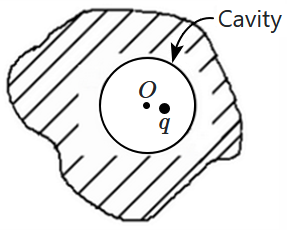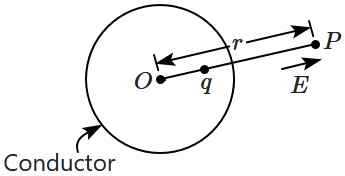
| 1. | zero |
| 2. | towards the centre |
| 3. | away from the centre |
| 4. | either towards or away from the centre depending on the sign of \(q\) |

To unlock all the explanations of this course, you need to be enrolled.

To unlock all the explanations of this course, you need to be enrolled.

| 1. | \(2E\) | 2. | \(\Large\frac{3E}{2}\) |
| 3. | \(\Large\frac{4E}{3}\) | 4. | \(\Large\frac{5E}{4}\) |

To unlock all the explanations of this course, you need to be enrolled.

To unlock all the explanations of this course, you need to be enrolled.
| Assertion (A): | The electrostatic field of a charge distributed uniformly over the surface of a sphere vanishes within the sphere, only at its centre. |
| Reason (R): | This cancellation occurs at the centre due to the symmetry of the sphere and the symmetric, uniform charge distribution. |
| 1. | Both (A) and (R) are True and (R) is the correct explanation of (A). |
| 2. | Both (A) and (R) are True but (R) is not the correct explanation of (A). |
| 3. | (A) is True but (R) is False. |
| 4. | (A) is False but (R) is True. |

To unlock all the explanations of this course, you need to be enrolled.

To unlock all the explanations of this course, you need to be enrolled.
Note: \(A,B,C\) are conductors. Other charges may be present in the vicinity.

| 1. | I, III | 2. | II |
| 3. | I, II, III | 4. | none of I, II, III |

To unlock all the explanations of this course, you need to be enrolled.

To unlock all the explanations of this course, you need to be enrolled.
| 1. | \(3\sqrt3\) | 2. | \(\dfrac{3\sqrt3}{2}\) |
| 3. | \(\sqrt3\) | 4. | \(\dfrac{\sqrt3}{2}\) |

To unlock all the explanations of this course, you need to be enrolled.

To unlock all the explanations of this course, you need to be enrolled.
| \(\mathrm{(A)}\) | A positive point charge \(q\) is placed at the centre of an uncharged conducting sphere. Electric field is measured outside the sphere, as a function of the distance \((r)\) from the centre. |
\(\mathrm{(I)}\) | \(E=0\) |
| \(\mathrm{(B)}\) | A positive point charge \(q\) is placed within an uncharged conducting sphere, but not at its centre. Electric field is measured outside the sphere, as a function of distance \((r)\) from centre \((O).\) |
\(\mathrm{(II)}\) | \(E={\Large\frac{kq}{r^2}}\) |
| \(\mathrm{(C)}\) | A pair of point charges \((+q,-q)\) are placed within an uncharged conducting sphere, symmetrically about its centre \((O).\)  Electric field is measured at \(P\) outside the conductor, but on the axis of the dipole. The distance \(OP=r.\)
Electric field is measured at \(P\) outside the conductor, but on the axis of the dipole. The distance \(OP=r.\) |
\(\mathrm{(III)}\) | \(E<{\Large\frac{kq}{r^2}}\) |
| \(\mathrm{(D)}\) | A positive point charge \(q\) is placed outside a spherical conductor, with the centre \(O.\) Electric field \(E\) is measured at a point \(P,\) radially along the direction of the point charge from \(O,\) and the distance \(r\) is measured from \(q.\)
Electric field \(E\) is measured at a point \(P,\) radially along the direction of the point charge from \(O,\) and the distance \(r\) is measured from \(q.\) |
\(\mathrm{(IV)}\) | \(E>{\Large\frac{kq}{r^2}}\) |
| 1. | \(\mathrm{A \text- I, B\text- I, C\text- III, D\text- IV}\) | 2. | \(\mathrm{A\text- II, B \text- IV, C \text- III, D \text- II}\) |
| 3. | \(\mathrm{A \text- II, B \text- II, C\text - I, D \text- III}\) | 4. | \(\mathrm{A \text- I, B \text- IV, C \text- I, D \text- IV}\) |

To unlock all the explanations of this course, you need to be enrolled.

To unlock all the explanations of this course, you need to be enrolled.

1. \(qE =Mg\)
2. \(2qE =Mg\)
3. \(qE =2Mg\)
4. \(\sqrt{2}qE =Mg\)

To unlock all the explanations of this course, you need to be enrolled.

To unlock all the explanations of this course, you need to be enrolled.
| 1. | \(F_C=0,F_M\neq0\) | 2. | \(F_C\neq0,F_M=0\) |
| 3. | \(F_C=0,F_M=0\) | 4. | \(F_C\neq0,F_M\neq0\) |

To unlock all the explanations of this course, you need to be enrolled.

To unlock all the explanations of this course, you need to be enrolled.
The dipole experiences:
1. no force and no torque.
2. a force but no torque.
3. a torque but no force.
4. a force and a torque.

To unlock all the explanations of this course, you need to be enrolled.

To unlock all the explanations of this course, you need to be enrolled.
| Statement I: | Gauss's law for electric fields is a consequence of the conservation of energy. |
| Statement II: | Coulomb's law for electric charges leads to a conservative electric field. |
| 1. | Statement I is incorrect and Statement II is correct. |
| 2. | Both Statement I and Statement II are correct. |
| 3. | Both Statement I and Statement II are incorrect. |
| 4. | Statement I is correct and Statement II is incorrect. |

To unlock all the explanations of this course, you need to be enrolled.

To unlock all the explanations of this course, you need to be enrolled.






